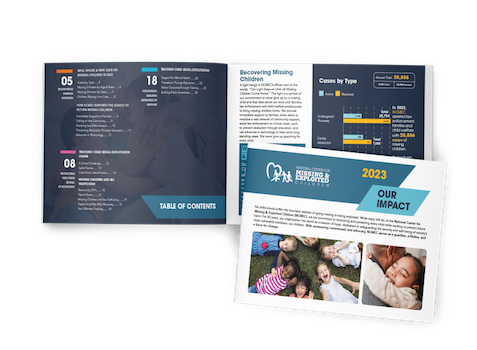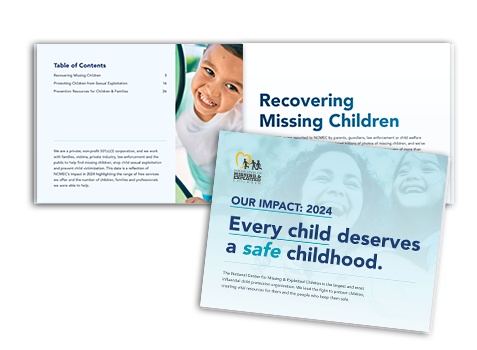Every child
deserves
a safe childhood.
The National Center for Missing & Exploited Children is the largest and most influential child protection organization. We lead the fight to protect children, creating vital resources for them and the people who keep them safe.

We are a private, non-profit 501(c)(3) corporation and we work with families, victims, private industry, law enforcement and the public to help find missing children, stop child sexual exploitation and prevent child victimization. This data is a reflection of NCMEC's impact in 2024 highlighting the range of free services we offer and the number of children, families, and professionals we were able to help.
Recovering
Missing Children
Missing children are reported to NCMEC by parents, guardians, law enforcement or child welfare professionals. In the past 40 years we've circulated billions of photos of missing children, and we've assisted law enforcement, families and child welfare professionals with the recovery of more than 450,000 cases of missing children.
Overall Recovery of Missing Children Reported to NCMEC in 2024
In 2024 the overall recovery of missing children reported to NCMEC was 91%. Missing children reports to NCMEC reflected trends similar to previous years with children who run away making up the majority of cases. These children are highly vulnerable and face risks including physical and sexual violence, homelessness, exposure to substance use and child sex trafficking. Family abductions, were the second most common type of case and have serious and harmful effects on child victims and their families.
NCMEC saw a significant number of missing child reports from child welfare professionals. NCMEC assisted with 23,160 reports of children missing from foster or state care. 92% of these children were recovered.
Reports by Type
Table: Reports of missing children to NCMEC between 1/1/2024 and 12/31/2024.The data in this section includes all missing cases reported to us, including missing young adults, ages 18-20.
| col | |||
|---|---|---|---|
| col | |||
| Grand Total | 0 | 0 | 0 |
Missing Children by
Age & Race/Ethnicity
Table: Missing children reported to NCMEC between 1/1/2024 and 12/31/2024 by child's age group and race/ethnicity.
Organized by Child's Age Group and Race/Ethnicity
| col | |||||||||
|---|---|---|---|---|---|---|---|---|---|
| col | |||||||||
| Grand Total | 0 | 0 | 0 | 0 | 0 | 0 | 0 | 0 | 0 |
Missing Children by State
Missing State and Case Status
| col | |||
|---|---|---|---|
| col | 0 | 0 | 0 |
| Grand Total | 0 | 0 | 0 |
*With the exception of children missing from state or foster care, there is no mandatory reporting of missing children to NCMEC.
NCMEC Resources & Support
NCMEC offers a wide range of services and support to help locate missing or exploited children. After a missing child case is reported to NCMEC, a case manager is assigned to serve as the primary point of contact for the family. Our case managers work with NCMEC analysts to support law enforcement's efforts to recover missing children and identify victims of child sex trafficking.
Below are some of the services NCMEC provides:
Call Center
1-800-THE-LOSTOur call center specialists are available 24/7 to support families of missing and exploited children. Our national, toll-free hotline, 1-800-THE-LOST, has responded to more than 5 million calls.
AMBER Alerts
AMBER Alerts are activated in the most serious child abduction cases. These alerts are broadcast through radio, television, road signs, cell phones and other data-enabled devices. The U.S. Department of Justice's Office of Justice Programs tasked NCMEC with managing the AMBER Alert Secondary Distribution Program. When law enforcement issues an AMBER Alert, NCMEC is notified and redistributes the alerts to the appropriate secondary distributors.
In 2024, 68 children were reported as rescued due to the activation of an AMBER Alert. As of December 31, 2024, at least 1,268 children have been recovered due to the activation of an AMBER Alert.
Team Adam
Team Adam, named for Adam Walsh, the abducted and murdered son of NCMEC cofounders John and Revé Walsh, is a network of retired law enforcement professionals and other experts that NCMEC deploys to the scene of critical missing child cases. They provide technical assistance and connect families and law enforcement to NCMEC's vast network of resources. They also provide consultation on long-term missing children cases.

Age Progressions, Facial
Reconstructions & Identifications
NCMEC provides forensic services to law enforcement, medical examiners and coroners to assist in finding missing children, identify unknown deceased children and develop leads on child homicides. When a child has been missing for more than two years, a photograph may no longer reflect the child's current appearance. Because of this, NCMEC artists create age-progression images so the public has a more accurate representation of what the child could look like now.
NCMEC works with DNA labs and genealogists who leverage DNA databases and forensic genealogy to help identify unknown deceased children or find long-term missing children. In 2024:
Operational Support
As part of our work to identify and recover missing children and child sex trafficking victims, NCMEC provides support to critical law enforcement operations. This includes advanced analytical information on missing children and leads related to their possible location.
Protecting Children
from Sexual Exploitation
NCMEC stands at the forefront of the fight to protect children from sexual exploitation, rising to meet the demands of evolving threats. NCMEC continues to address new trends in online child safety, offering vital tools and services to victims, families and other child-serving professionals.

CyberTipline
NCMEC's CyberTipline is the nation's designated system for members of the public and electronic service providers to report suspected child sexual exploitation, including child sexual abuse material, child sex trafficking and online enticement.
total reports of suspected child sexual exploitation online.
Types of Cases Reported to the CyberTipline in 2024
Table: Reports of suspected child sexual exploitation made to NCMEC's CyberTipline between 1/1/2024 and 12/31/2024.
| column |
0
|
| Total | 0 |
Files in CyberTipline Reports
Graphic: Files included in reports of suspected child sexual exploitation made to NCMEC's CyberTipline between 1/1/2024 and 12/31/2024.In 2024, reports to the CyberTipline included

Take It Down
Take It Down is a free service to help people remove nude, partially nude or sexually explicit photos and videos taken before they turned 18 that are posted online. It is available in 33 languages and works by creating a unique hash value for each image and video that can assist participating platforms with removing them or stopping the circulation.
In 2024, we received more than 83,000 submissions to Take It Down including more than 166,000 hashes.
Child Victim Identification
NCMEC's Child Victim Identification Program (CVIP) is the nation's premier team in helping law enforcement identify child victims of CSAM. CVIP analytically pieces together information from these images and shares their findings with law enforcement both domestically and internationally. Since 2002, CVIP has reviewed more than 430.6 million images and videos.
In 2024, NCMEC received 5,251 requests from law enforcement and analyzed more than 22.3 million images and videos of child sexual abuse.
| col | |||
|---|---|---|---|
| col | |||
| Total | col | col | col |
Actively Traded Images & Videos
NCMEC's CVIP is aware of more than 31,770 child victims who have been identified by law enforcement. Of these, 3,244 children are depicted in “actively traded” imagery, meaning the images or videos have been seen in multiple reports to NCMEC.
| col |
|---|
| col % |
| col | ||||
|---|---|---|---|---|
| col | ||||
| Total | 0 | 0 | 0 | 0 |
Child Sex Trafficking
Child sex trafficking is a crime that can happen anywhere. NCMEC has received reports from all 50 U.S. states, Washington, D.C. and Puerto Rico. It also happens in every type of community, including urban, suburban, rural and tribal lands. Additionally, children who run away are disproportionately targeted by traffickers and buyers who prey upon a child's need for love, acceptance, food and shelter.
There's no one version of what child sex trafficking looks like. NCMEC receives reports of non-familial traffickers such as pimps, romantic partners, or gang members targeting and exploiting children. Other reports involve children victimized while living at home and trafficked by their biological father, mother or other family members.
Of the more than 29,000 missing children reported to NCMEC in 2024, 1 in 7 were likely victims of child sex trafficking. NCMEC's Child Sex Trafficking Team provided analytical support to law enforcement on more than 27,800 reports regarding possible child sex trafficking.
| col | ||||
|---|---|---|---|---|
| col | ||||
| Total | 0 | 0 | 0 | 0 |
Victim Demographics
| col | ||||
|---|---|---|---|---|
| col | ||||
| Total | 0 | 0 | 0 | 0 |
Supporting Kids After Recovery
Survivors of child sex trafficking have experienced significant trauma. Ensuring they receive support, including trauma-informed response and specialized services immediately upon recovery, is crucial to their healing.

Sex Offender Tracking
NCMEC's Sex Offender Tracking Team assists law enforcement in their efforts to locate noncompliant sex offenders. The team also works to link information about noncompliant sex offenders to unresolved cases of missing and sexually exploited children to NCMEC.
In 2024, NCMEC assisted with 19,861 requests to help locate noncompliant sex offenders. Of those, 2,990 noncompliant sex offenders were subsequently located and arrested.
NCMEC also assisted with seven local, state and national noncompliant sex offender operations.

Prevention Resources for
Children & Families
In addition to helping locate missing children and reducing child sexual exploitation, NCMEC also works to prevent further victimization of children. This includes providing mental health support to families who have experienced a missing or exploited child to help them on the path to healing, creating education programs that empower children and families to make safer decisions online and offline, leading training sessions for child-serving professionals and expanding our public engagement through social media.

Support for Mental Health
In 2024, NCMEC provided 1,571 victims and families with mental health services that include education about resources, crisis support, and referrals to mental health/therapy providers near them for longer-term support.
NCMEC facilitates the Family Advocacy Outreach Network (FAON), which is a membership-based network of experienced mental health professionals and organizations. FAON had 386 members who provide crucial mental health services on a free or sliding scale.
Our nationwide volunteer peer-support group, Team HOPE, provides emotional peer support to parents and family members of missing and exploited children, as well as adults who were missing and/or exploited when they were children. In 2024, 2,886 individuals contacted Team HOPE for the first time.
Prevention Resources & Training

NCMEC receives millions of reports every year about missing and exploited children through our hotline, 1-800-THE-LOST and our CyberTipline. NCMEC uses data from these reports to identify trends and create educational resources to address the evolving needs of children.
NetSmartz and KidSmartz are free, age-appropriate resources designed for children, parents and child-serving professionals.
NCMEC provides ongoing training to partners in law enforcement, other nonprofits and child-serving organizations to deliver safety presentations. In 2024, we trained 349 new professionals to deliver our internet safety presentations, providing lessons directly to 86,178 children and 10,841 parents and caregivers.
In 2024, NCMEC provided 41,909 instances of training to child-serving professionals to enhance their ability to prevent or respond to cases of missing or exploited children.
NCMEC Connect, is a virtual gateway to on-demand trainings, resources and best practices related to missing and exploited children. In 2024, NCMEC Connect had more than 26,355 registered users.

NCMEC's Missing Kids Readiness Program (MKRP) promotes best practices for training and policies for law enforcement and emergency communication centers responding to cases of missing and exploited children. In 2024, 31 public safety agencies completed the policy review and online training to become new or renewed members agencies.
2024 Our
Impact Report
Archives



